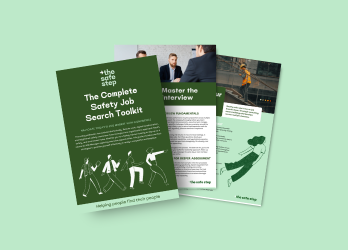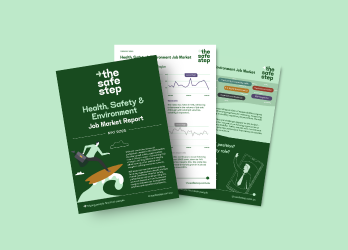The future-ready Safety leader
Page Published Date:
September 9, 2024
The future-ready Safety leader
As a Safety leader, you're no stranger to change. But are you prepared for the significant shifts reshaping the profession? From the complexities of psychosocial risk management to the strategic imperatives of ESG, the ground beneath our feet is moving faster than ever.
At a recent Australian Institute of Health & Safety (AIHS) event, supported by The Safe Step and MinterEllison, industry leaders gathered to discuss what it means to be a future-ready Safety leader. Discussions paint a picture of a profession in flux and one that demands not just adaptation, but transformation. Read on to learn more.

The changing face of risk management
The future-ready Safety leader recognises that risk management is no longer a straightforward task. Christian Frost, Group Executive - Business Evolution at Ventia, highlighted this evolution: "The psychosocial landscape is becoming increasingly complex. There's an opportunity here to move beyond risk management and step into cultural transformation."
If you're feeling like you haven't quite "nailed" psychosocial risk management yet, you're not alone. Even the most seasoned Safety leaders are grappling with its true complexity. This sentiment underscores the need for continued innovation, adaptation and proactive management in this space.
Breaking down silos
Harriet Eager, Partner in Workplace Law at MinterEllison, highlighted the growing need for Safety to work hand-in-glove with other business functions: "We're seeing emerging roles like psychosocial risk managers. It's crucial for Safety professionals to educate legal colleagues about these less visible safety issues."
This cross-functional approach extends to emerging challenges such as the "right to disconnect", sexual harassment prevention and impacts of domestic violence in the workplace. As Richard Coleman, experienced Safety executive and event facilitator, pointed out: "Traditionally, issues like domestic violence have been dealt with by HR. But the world's a different place now. We have to think about different solutions."
Tech savvy safety
The role of technology in Safety management is expanding rapidly. AI and advanced data analytics are becoming essential tools for forecasting and managing Safety challenges.
As Christian Frost emphasised, "We need to leverage technology to see how challenges come through the business and to forecast future risks. This is becoming an essential skill for Safety leaders."
Many future-ready Safety leaders are already upskilling themselves and their teams, befriending their IT departments and getting their tech-stack in order.
The talent challenge
If you're struggling to fill Safety roles, you're not imagining things. Katie Johnson, Director at The Safe Step, confirmed the talent squeeze: "The number of advertised HSE roles is increasing, and demand is high. Supply can't keep up, and employers are competing for the same talent pool." She advises Safety leaders to focus on workplace flexibility and competitive pay to attract and keep top talent.
Future-focused Safety leaders are also grappling with where the next generation of safety professionals will come from, with fewer new graduates entering the field. This trend is pushing forward-thinking leaders to reimagine talent development, embracing non-academic pathways and a more diverse range of backgrounds.
Leaders are exploring innovative approaches: diverse pathways into the profession, micro-credentials, industry-education partnerships and robust mentoring programs. As Frost emphasised, "We need to think beyond traditional safety skills. Commercial acumen, marketing skills and the ability to drive organisational change are becoming crucial for Safety leaders."
The ESG imperative
Environmental, Social and Governance (ESG) considerations are increasingly shaping corporate strategy, presenting new opportunities for Safety leaders to demonstrate value at the board level.
Harriet Eager put it succinctly: "ESG is an opportunity for Safety professionals to broaden their skills and retain a seat at the table. We have the skill sets to work and lead in this space, particularly in areas like risk management and auditing."
However, the landscape is shifting rapidly. Katie Johnson observed, "We're seeing ESG responsibilities sometimes moving out of safety and under finance for reporting purposes. There's increasing pressure and complexity connected to ESG." This shift underscores the need for Safety leaders to collaborate across functions and position themselves as key players in the ESG narrative. Future-ready Safety leaders will need to speak the language of finance, sustainability and risk management to effectively navigate this evolving landscape.
Legislative complexity and board-level scrutiny
The regulatory landscape for Health & Safety is becoming increasingly complex, requiring leaders to be adept at interpretation and influence.
Harriet Eager highlighted this challenge: "Legislation is no longer spoon-fed to us. We need to digest it, think critically and educate our colleagues. Safety leaders must be able to put a safety lens on complex topics and effectively influence senior leadership."
Future-ready Safety leaders must go beyond mere compliance. They need to foster a culture where safety considerations are integrated into every decision. As Eager emphasised, "We need to grapple with the topics, put a Safety lens on it and talk to leaders." This approach ensures that safety isn't just the domain of Safety professionals, but becomes a shared responsibility across the organisation.
Where to next?
The future of Safety leadership is characterised by increased complexity, broader scope and greater strategic importance. Success at the leadership level of the profession requires being adept at navigating this complex landscape, influencing across all levels of the organisation and driving meaningful cultural change.
Christian Frost believes the Safety profession's future is bright for those ready to tackle these evolving challenges head-on: "There's an opportunity for the profession to step into the culture space much more than what we've done in the past. We can use the psychosocial agenda as an opportunity, rather than just a risk to be managed."
In-demand leaders will be versatile professionals – part strategist, part cultural architect and part change agent. They will need to be as comfortable analysing data and presenting to the board as they are walking the shop floor and engaging with frontline workers. By embodying safety practices and demonstrating their value across all levels of the organisation, these leaders will elevate the role of Safety from a compliance function to a key driver of organisational success.
Are you prepared to step into this multifaceted role and shape the future of Safety leadership in your organisation?




